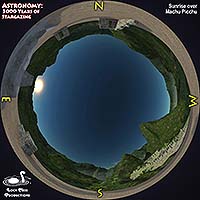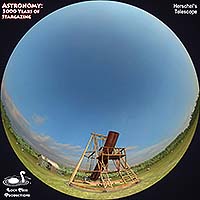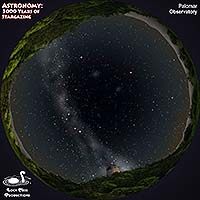Astronomy: 3000 Years of Stargazing
Take an historical odyssey to learn about our oldest science!
Updated in 2020!
Throughout time, the sky has piqued our curiosity. Eclipses, the regular cycle of the seasons, the rising and setting of the Moon, Sun, and planets, the motion of the stars — all have fascinated mankind since our earliest ancestors first looked up. Monuments constructed across our home planet, from Stonehenge to Machu Picchu, bear witness to humanity's ancient fascination with the stars.
With occasional observations from a learned cartoon astronomer, "Alvin Astro", we retrace the milestones of cosmic discovery in this engaging history of astronomy. Rediscover the major astronomical theories of the last 3,000 years — from the cosmological models of antiquity and the Ptolemaic system of epicycles — to the contributions of Copernicus, Galileo, Kepler, Newton, Herschel and Hubble. From Galileo's telescope to modern instruments used on Earth and in space, see how cutting-edge technology reveals a multi-wavelength universe of planets, star birth regions, nebulae, pulsars, black holes and galaxies.
Astronomy: 3000 Years of Stargazing combines the videography and animation created by Antares Fulldome of Barcelona (who originally produced the show in 2009) with the soundtrack expertise of Loch Ness Productions. Our version features a revised script and narration by Carolyn Collins Petersen, plus music from the vast resources of the original and popular planetarium space music library created by Mark C. Petersen. Mark also provides the voice of Alvin Astro.
Take your audiences on an historical odyssey, to uncover the many accomplishments humans have made as we seek to understand the cosmos!
 Running time: 33:33
Running time: 33:33
Suitable for: General public
Information about: History of astronomy
Year of production: 2010, revised 2020
Don't see the language you want? Let's work together with the producer to create it. Read more here!
Astronomy: 3000 Years of Stargazing focuses on the history of astronomy with emphasis on how people have used the sky throughout history. First we used it to help understand and predict the seasonal cycles of weather. Then, with the invention of instruments to observe objects in the sky, the science of astronomy developed into a system of understanding the intrinsic nature of those objects. These concepts are woven together along with historical and cultural perceptions of the sky and help relate the information presented in the show to the lives of students, families, and the general public.
Show content is relevant in the following subject areas:
Physical Science, Life Science, and Earth and Space Science Standards
- objects in the sky: Sun, Moon, stars, planets, galaxies, quasars
- properties of stars
- creation of the universe (the Big Bang)
- position and motion of objects in space
History and Nature of Science
- astronomy as a human endeavor
- history of astronomy and historical perspectives
- the nature of astronomy
Science and Technology
- Understanding of how astronomy technology has been developed and how it works
Science as Inquiry
- Understanding the concepts behind the motions of sky objects
- Realizing how we know what we know about astronomy
- What one needs in order to understand the cosmos
Science in Personal and Social Perspectives
- change in the sky
- early maps of the sky
- rise of scientific exploration of the universe
- development of the modern science of astronomy
- early human history, cultures, and perceptions of the sky







